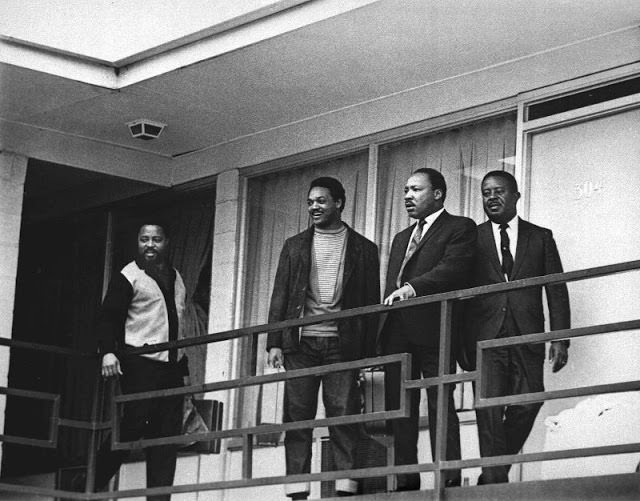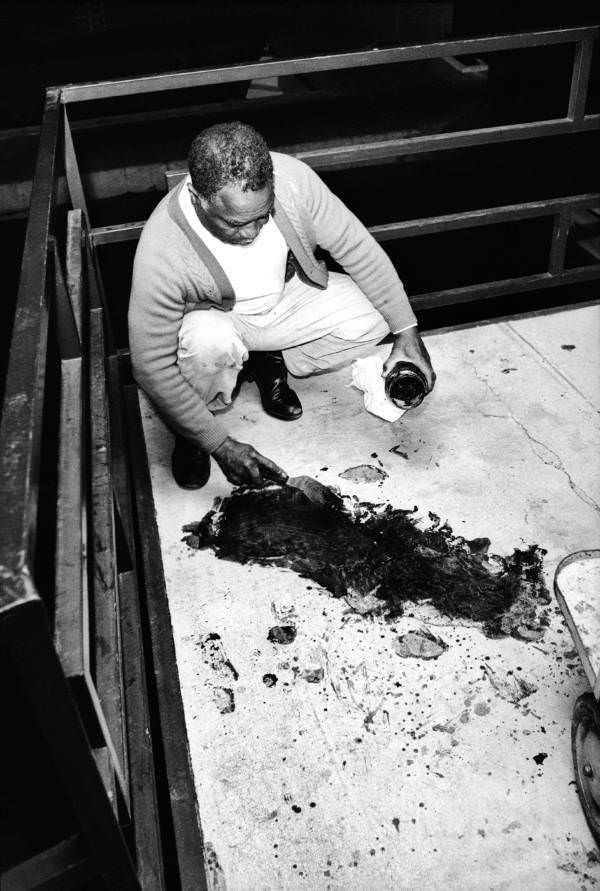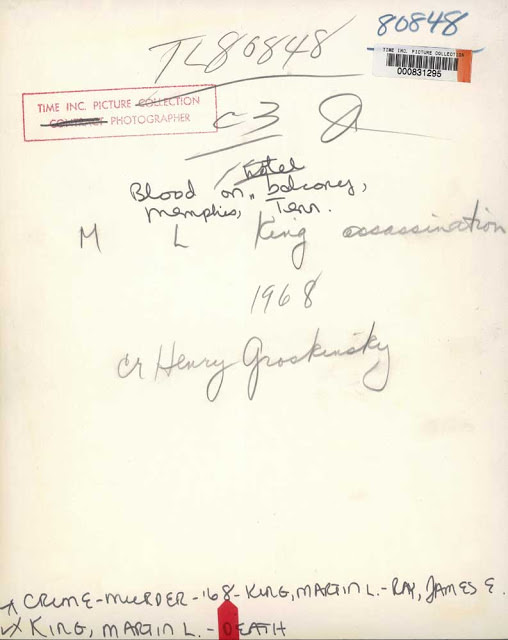The death of civil rights activist Martin Luther King, Jr. shocked the world. He was assassinated on April 4, 1968, in Memphis, Tennessee. While standing on the balcony of his hotel, he was shot by James Earl Ray. Martin had given a speech the day before he was shot. His murder, James Earl, was sentenced to life imprisonment and died in jail in 1998. Photographer Joseph Louw was working on a documentary about Martin Luther King Jr. He finished his dinner earlier on the same day when MLK was assassinated. Louw was staying three doors down from King when he heard the fire shot; he bought his camera. “it was just a matter of realizing the horror of the thing. Then I knew I must record it for the world to see.” He told Life. Louw captured the chaos and emotions of people. He shot four rolls of film, but one photograph remained emblazoned. It was the photograph of King’s comrades who were pointing their fingers towards the assassin. The same day another LIFE photographer Henry Groskinsky and writer Mike Silva visited the location where King was murdered. They accessed and photographed the building and motel’s ground and the location from which the gunshot likely came. These photographs below show the assassination and moments after the assassination of Martin Luther King Jr.
#1 King delivering his now famous “I’ve Been to the Mountaintop” speech at the Mason Temple in Memphis to 2,000 people the night before he was killed. April 3, 1968

This would be the last speech he would ever give, and this photo would be one of the last ever taken.
#2 Martin Luther King standing on the balcony on the day of his assassination along with his best friend Ralph Abernathy on the right. On the left is Jesse Jackson, to his left another preacher.

#3 Civil rights leader Andrew Young (L) and others standing on balcony of Lorraine motel pointing in direction of assailant after assassination of civil rights ldr. Dr. Martin Luther King, Jr., who is lying at their feet.

#4 The first police officer made it on to the balcony. The man standing to the right of the police officer is King’s best friend Ralph Abernathy. You can see the pain on that man’s face as he’s looking down at his friend dying.

#5 Ralph Abernathy and others crouched down tending to King who has a small white Motel towel on the wound in his right jaw.

#6 The limp, lifeless body of Dr. Martin Luther King, splayed out on the second-floor balcon of the Lorraine Motel — which is now a National Civil Rights Museum.

#7 King’s aides try to help their leader in any way they can, after he was shot by self-confessed assassin James Earl Ray. Ray later claimed others were involved, which many in the King family believe.

#8 The other man bent down on the right side of Martin Luther King is Andrew Young, a preacher and friend of King.

#9 Police try to get him onto a stretcher.

#10 Police and paramedics getting King situated on the stretcher by strapping him on and what not. Notice the spot of blood on one of the officer’s hands.

#11 An unidentified man uses a blanket to cover the body of Martin Luther King, Jr., moments after he was shot in the face.

#12 Police and ambulance workers carry the body of Martin Luther King, Jr. down the stairs of the Lorraine Motel. Riots in over 100 American cities would break out shortly after.

#13 An ambulance arrives at site of Martin Luther King’s assassination.

#14 Bystanders run to search for the then-unknown assassin who shot Martin Luther King Jr. from a building just across the Lorraine Motel.

#15 Police officers assess the scene at the Lorraine Motel, moments after King is rushed to the hospital and pronounced dead.

#16 Police respond to assassination of civil rights leader Martin Luther King Jr.

#17 Will D. Campbell, alone on the Lorraine Motel balcony, gazes out into the night.

"This picture was probably made as soon as we got there," Groskinsky told LIFE. "When I saw him standing there, alone, I thought it looked as if he was just asking himself, My God, what has happened here?"
#18 The Lorraine Motel photographed in the hours after Dr. King’s assassination, April 4, 1968.

#19 Outside of room 306, Theatrice Bailey, the brother of the Lorraine Motel’s owner, cleans blood from the balcony. “There was no friction with the people there at the Lorraine,” Groskinsky recalled, “even though here was this white man with a camera on the scene.”

#20 Theatrice Bailey, brother of the motel’s owner, scrapes King’s blood from the balcony on the night of the man’s death.

#21 The bloodstained second-floor balcony of the Lorraine Motel, where Dr. Martin Luther King, Jr. was gunned down by an assassin.

#22 The back of a photograph taken by LIFE photographer Henry Groskinsky on April 4, 1968, at the Lorraine Motel, Memphis, Tenn.

#23 #23 The building on the left is the abandoned building from which Groskinsky took several of his photographs on the night of April 4.

"It was a little scary crawling into the building, because who knew who was going to be there? Who doesn't want you to be there? The atmosphere was very dark, very creepy."
#24 Colleagues gather on the balcony outside the Lorraine Motel’s room 306, just a few feet from where Dr. King was shot, April 4, 1968.

#25 Martin Luther King, Jr.’s neatly packed, monogrammed briefcase in his room at the Lorraine Motel, April 4, 1968 — with his brush, his pajamas, a can of shaving cream and his book, Strength to Love, visible in the pocket.

#26 Stunned, silent members of the Southern Christian Leadership Conference in Dr. King’s room at the Lorraine Motel, April 4, 1968.

including Andrew Young (far left, under table lamp) and civil rights leader and Dr. King's colleague, Rev. Ralph Abernathy, in the middle on the far bed. "I was very discreet," Groskinsky recalled. "I shot just enough to document what was going on. There, almost in the center of the picture, in the mirror, you can see my reflection. I took a couple of pictures and just kind of backed off."
#27 Religious and Civil Rights leaders Will D. Campbell (right) and Ralph Abernathy embrace and comfort one another in King’s room (no. 306) at the Lorraine Motel on the night of his death.

#28 A photo taken through tree branches by Henry Groskinsky from a derelict building across the street from the Lorraine Motel, April 4, 1968, very close to where the shot that killed Dr. King likely came from.

#29 An airplane dispatched by the U.S. government to retrieve Dr. King’s body and return it to Atlanta, Ga., waits on the tarmac in Memphis, Tenn., the day after MLK’s assassination.

"Here we were, two white guys in the Deep South right after the murder of the preeminent leader of the black community — voyeurs, in a sense," Groskinsky told LIFE. "We were apprehensive about it. But when we got there, there were no big problems for us."
#30 The population of Memphis, as well as people in 100 other American cities, took to the streets in anger, fear, and desperation. April 4, 1968. Memphis, Tennessee.

#31 Jesse Jackson saw King give “the most brilliant speech of his life” the night before he was gunned down. He’s seen here at O’Hare Airport in Chicago, reading the Daily Defender newspaper in hopes to learn more. April 5, 1968. Chicago, Illinois.

#32 The Illinois National Guard patrol the riot-affected Westside of the city. Police said at least nine people were killed during the chaos, with over 343 arrested.

Around 3,000 troops were brought in to quell the panic and anger triggered by the murder of Dr. Rev. Martin Luther King Jr. April 6, 1968. Chicago, Illinois.
#33 Streets and buildings are ablaze from rioting and looting following the tragic assassination of Martin Luther King Jr.

#34 In Chicago, 11 people died during the riots, which left thousands homeless, and damaged over $10 million worth of property.

#35 In the days and weeks that followed MLK’s assassination, devastated demonstrators in more than 100 cities across the U.S. hit the streets in a wave of rioting that remains unprecedented in the nation’s history.

Cities hit hardest by the rioting included Washington, D.C. (where 1,000 were injured and 6,000 were arrested).
#36 Women at the Abe Schrader clothing shop in New York pause during work to listen to the funeral service for Martin Luther King Jr. on a portable radio. April 8, 1968. Memphis, Tennessee.

#37 King intended to lead the “March on Memphis” for the striking sanitation workers, but tragically didn’t live to see it. His widowed wife, Coretta Scott King (fifth from right), led it instead. April 9, 1968. Memphis, Tennessee.

#38 James Earl Ray, Martin Luther King’s assassin, being led to his cell in Memphis after his arrest in London, June 8, 1968.




Wow, I never really considered the details of this until now.
The photos were shocking. I’d never seen most of them until now. Excellent post.
A museum was built nearby where he was killed, and I’ve been there. The hotel room is exactly as he left it; it’s absurd
I learned so much. Thank you for posting.